
|
Random noise in the E-3 and E-300 |

|
My other articles related to the |
|
Noise is one of the aspects of digital camera image quality, with its importance usually overestimated in the digital folklore. It is not as important as many people think it is, but above a certain level it may become disturbing in the resulting images. Note: unless you are preoccupied with noise issues, or want to know how I arrived to some of my conclusions, do not waste your time reading the full thing; just jump to The Bottom Line and use the saved time for something else. Before continuing, you may want to refer to my general introduction to the subject. Here let me only state that this article deals with the random noise, the component dominant in relatively short exposures — below one second or so, most commonly used in photographer's practice. This small study was performed to see how the noise behaves in the new E-30 by Olympus. To put my findings into perspective, I'm also including newly-generated results for the E-3, so that the article will be also useful for those interested in the latter. My high ISO image samples from the E-30 show clean images at ISO 100 to 400, almost as good at ISO 800, usable at ISO 1600, and salvageable at ISO 3200. In the latter case, using the Neat Image or a similar external application will usually allow for presentable prints of 9×12 inches and maybe beyond. Comparing these samples against ones from the E-3 shows that noise levels in both cameras are in the same ballpark. The goal of the present article is to make the comparison less subjective. Noise metrics In addition to cleaning up noise. Neat Image provides a way to measure its severity: it computes the overall noise amplitude metrics, averaged over various frequencies (grain sizes) and components (luminance, chrominance). This metrics is better for comparisons than the standard deviation of pixel-level distributions (the latter is, I'm afraid, useless and misleading and should not be used at all). This is the metrics I've chosen for some quantitative comparisons. | |
|
For best results, program authors recommend taking a picture of an out-of-focus target image off a computer screen. This has to be done for each combination of parameters used; and a resized example is shown here.
The alignment was off in this series, but this does not affect the results. This particular sample was shot with the E-30, 35 mm focal length, aperture priority (0 EV): 1/80 s at F/3.7, ISO 800. Sunny WB, sharpness and contrast at 0 in the Natural Picture Mode, noise filter at Standard. Links to some full-frame originals are provided further down. |
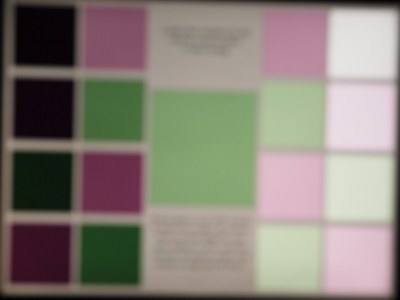
|
|
Qualitative comparison: image samples Before we compare the numbers, let us have a look at some comparison samples for both cameras, as the numbers do not tell everything. What follows are full-scale fragments of the test target sample images. Both cameras were set identically, with all relevant parameters (sharpness, contrast, noise filtering) at manufacturer's defaults, and with the ISO value varying from 100 to 3200. I'm using default settings here, as they reflect the Olympus' idea of the optimum compromises between various aspects of image quality; for my own work I prefer to have them adjusted a bit (all toned down). The 1:1 fragments were chosen prom the purplish area in the bottom-left corner, as this was where I could see more noise than anywhere else in the image. This is, I would think, because blue and red channel are noisier than the green one (remember: twice the number of photosites!), and also because this area has generally lower luminance. | |
| E-3 | E-30 | ||
|
When comparing both cameras remember that E-30 has 20% more pixels, or a (linear) pixel density larger by 10% than E-3. This puts it at some disadvantage in pixel comparisons. At the same viewing size, this camera will need 10% less magnification than the E-3, so that its noise will show less. Anyway, at ISO 100, the E-30 shows a hint of more noise, but both cameras perform well here. Viewing full images reduced to a 12×16" (1200×1600) monitor, I couldn't tell the difference. The E-3 images (all ISOs) are a tad darker then the E-30 ones, with a bit different color, too. (All were shot in the same session, under identical conditions, with identical settings.) Moving to ISO 200, we can see just a hint of noise increase for both cameras; perhaps more for the E-30. Still, I wouldn't be afraid to use ISO 200 as my base setting in that camera. This continues at ISO 400: the E-30 looks good, but E-3 — a bit better. I've been using ISO in the E-510 as a base setting for long telephoto (handheld) work, and I will be even more willing to do that with the E-30. |

|
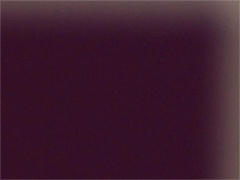
|
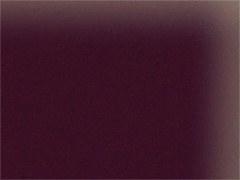
|
|---|---|---|---|

| 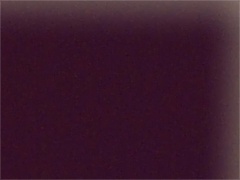
| 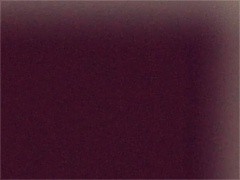
| |

| 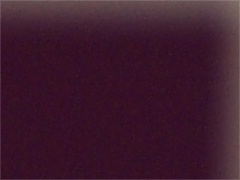
| 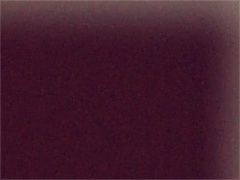
| |
|
At ISO 800 the subjective difference between both cameras seems to be quite at the same level as above. Then we come to ISO 1600. While in the fragments shown here the E-3 looks cleaner, this is just part of the truth. When viewing full frames (E-3, E-30), you can see that the E-30 noise is more random; in particular, it shows no horizontal banding, already visible in the darker areas of the E-3 sample. This I consider an improvement from the E-3. ISO 3200 shows quite a degradation. It should be used as a last resort, with noise removal applied in postprocessing. That does not come free, but it will provide better results than just cranking up the in-camera filtering.
Again, while the E-3 sample seems to have lower noise, it also suffers from banding, even more than at ISO 1600, while the E-3 passes this test just fine. (Full frames: Also, note the color shift in the E-3 sample. This is something I reported a year ago, showing at ISO 3200. The E-30 seems to be free from this problem. All this added together, I would say the E-30 performs slightly better at ISO 3200 than its big brother. | 
| 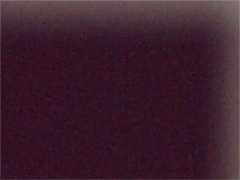
| 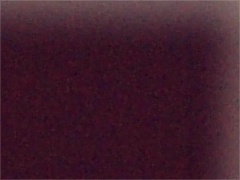
|

| 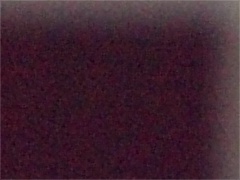
| 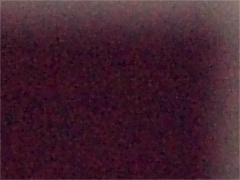
| |

| 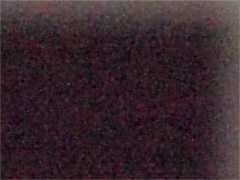
| 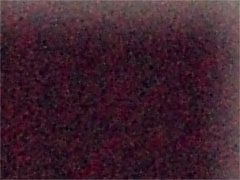
| |
|
Neat Image will try to remove the noise, as shown in the last pair of samples. (I used noise profiles generated from the full frames, and the default degree of noise removal.) How this affects the detail can be seen, for the E-30, here. | 
| 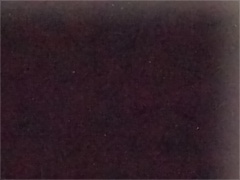
| 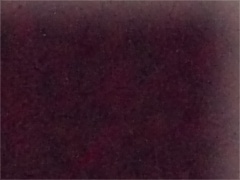
|
|
The comparisons shown here would be more meaningful were all the other things equal. The physics is such that all components of the noise increase with the ISO rating and this cannot be helped. The designers work around this with noise filtering, but this involves compromises: drop in the spatial resolution (detail) and possible image artifacts. These compromises are tweaked to each sensor type so that the achieved result is most "pleasing", whatever that means. This tweaking, I am sure, had to be different for the different sensors used in both cameras. | |
| Noise amplitude measured | |
|
Some subjectivity can be removed from all this by comparing the noise amplitude for both cameras at various settings. This can be done with use of Neat Image, as described in the Noise Metrics section above. Here I will present only a part of the data I've collected (90 data points per camera); namely, amplitude dependency on ISO for different sharpness/contrast and noise filter settings. Here is the graph showing my findings. | |
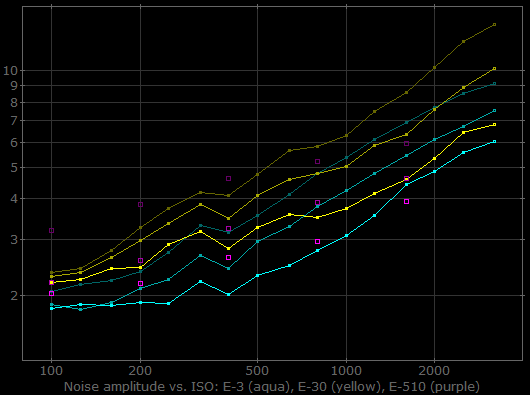
|
The E-3 data is drawn in aqua, that for the E-30 — in yellow. For each camera three lines are presented:
|
|
What is different in this presentation than in others, is that the vertical scale (noise amplitude) is drawn in logarithmic scale. This means that the same vertical distance in the graph corresponds to the same relative (or percentage, as opposed to absolute) difference between values. This scale is better in such comparisons. If the difference between the data for one line and another stays at a constant percentage, say, 50%, the lines will be drawn equidistant. In the linear scale they would be diverging; that's some may say "at small ISOs cameras A and B perform alike, but the difference is increasing at higher ones". Actually camera A may have a constant 50% advantage over B at all ISO settings. Secondly, we cannot use the data without knowing the uncertainty of the values. To check that I re-ran a small part (30 data points) of the measurements for one of the cameras — the whole process starting from shooting the target. The largest discrepancy between two points expected to be identical was 6%; most were below 3%. We can therefore claim that the amplitude error stays within 10%, which is a distance like that between 9 and 10 on the vertical axis. Now, this is lots of data, and while you may best interpret this by yourself, here are some of my observations:
The last one, comparing the numbers with samples, makes me suspect I'm just wasting my time writing this. Still, I wanted to be sure that the low priority I assign to noise specs is justified. I can tell it is. The E-30 shows slightly but consistently higher per-pixel noise levels than E-3, but the difference is hardly noticeable in full pixel scale, and even less so when the full image is printed or viewed on screen. The difference increases with the ISO setting. Some of this difference is balanced by the fact that images from the E-30 undergo less magnification for printing or viewing than those from the E-3. Sensor gain up to ISO 800 is usable for practically any purposes; if you want to be really nitpicky about this, limit yourself to ISO 400. ISO 1600 is quite presentable, and ISO 3200 — almost so, especially when a noise-removing application is used in postprocessing. (If that's your choice, then low in-camera noise filtration is recommended; best set to Off.) While noise amplitude at ISO 1600 and above is higher in the E-30 than in E-3, the noise has a more random structure (no banding, less clustering), which makes it "cleaner", and images — somewhat better. The camera does not suffer from color shift at ISO 3200, which was present in the E-3. Based on my experience so far, my recommendation for the relevant camera settings is: sharpness and contrast at -1 in the Natural Picture Mode, noise filtering at Low. This may change as I gain more experience with the camera, as the -2/Off setting (a close second in my book) can offer some advantages: more control over sharpening and noise filtration in postprocessing. (On the E-510 I keep the noise filter at Off.) Appendix: The numbers Since the original posting, I've received requests for the numeric values of noise amplitude as measured with the Neat Image: perhaps some Readers would like to compare them directly with some experiments of their own. While I am skeptical about such comparison between different cameras (this tells more about the policy chosen by manufacturers in reconciling the conflicting requirements), there is no harm, so here are the numbers. For brevity, I'm providing only those for "round" ISO settings. NF stands for noise filtering, and SC for sharpness and contrast as set in the Natural Picture Mode. Other parameters as described in the article. | |
| Camera | SC | NF | ISO 100 | ISO 200 | ISO 400 | ISO 800 | ISO 1600 | ISO 3200 |
|---|---|---|---|---|---|---|---|---|
| E-510 | 0 | Std | 2.04 | 2.19 | 2.63 | 2.96 | 3.93 | - |
| -1 | Low | 2.20 | 2.58 | 3.23 | 3.90 | 4.63 | - | |
| -2 | Off | 3.19 | 3.85 | 4.63 | 5.23 | 5.94 | - | |
| E-3 | 0 | Std | 1.83 | 1.91 | 2.02 | 2.76 | 4.44 | 6.05 |
| -1 | Low | 1.88 | 2.10 | 2.44 | 3.80 | 5.45 | 7.51 | |
| -2 | Off | 2.06 | 2.38 | 3.15 | 4.81 | 6.91 | 9.12 | |
| E-30 | 0 | Std | 2.20 | 2.45 | 2.81 | 3.50 | 4.60 | 6.81 |
| -1 | Low | 2.30 | 2.97 | 3.47 | 4.79 | 6.35 | 10.16 | |
| 2 | Off | 2.37 | 3.25 | 4.09 | 5.82 | 8.55 | 13.96 | |

|
My other articles related to the |
| Home: wrotniak.net | Search this site | Change font size |
| Posted 2009/02/04; last updated 2009/02/11 | Copyright © 2009 by J. Andrzej Wrotniak. |